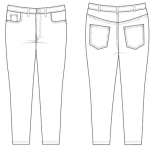One of America’s most beloved fabrics, denim can be a delight to sew if you know the tricks. Tools Always use sharp scissors or a new rotary cutter blade to cut clean edges on this dense fabric. On heavier denims, use spring clips to hold edges together for sewing, as opposed to pins which may […]
What I’m Sewing: Denim Jeans from Cashmerette
Our thanks to ASG member, Tina Gordon, for her review of this jeans pattern! Q. Item Created A. Denim Jeans Q. Independent Pattern Designer A. Cashmerette Q. Name and Number of Pattern A. Ames 4101 Q. Fabric Used: A. Stretch Denim with 2% Lycra Q. Special Embellishments/Notions Used A. Rivets, embroidered pockets Q. Skill level […]







